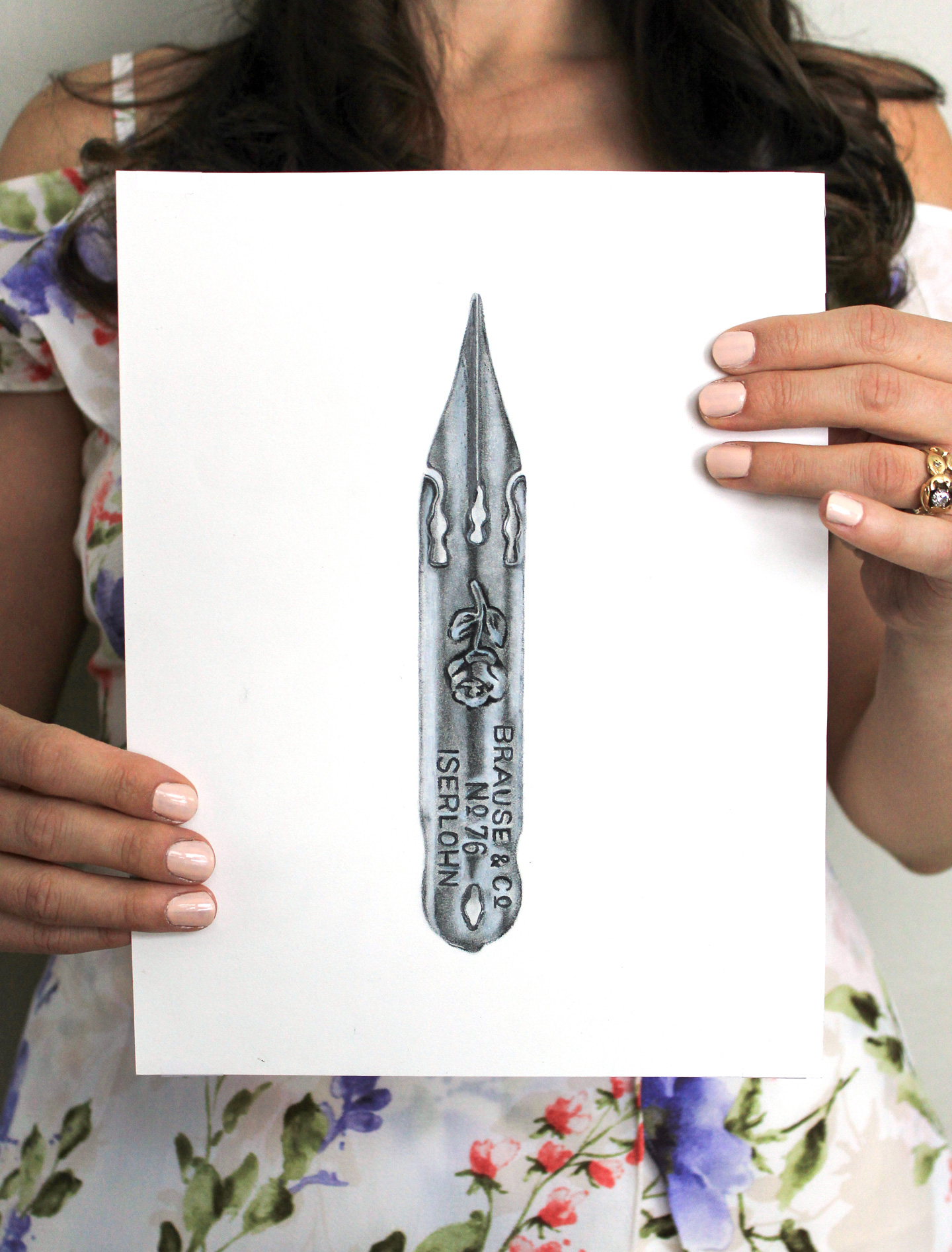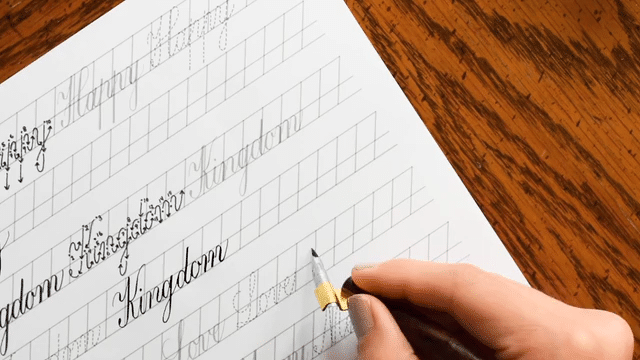
I am sure that there are a {very} small handful of calligraphers out there blessed with an uncanny ability to space correctly 99% of the time without the aid of a ruler. I am not one of them. No matter what type of calligraphy I am creating, I use some spacing method to ensure that my envelopes turn out perfect. Since it’s a service that my clients are paying for, I would feel uncomfortable not giving them my best work!
In today’s blog post, we are going to delve into the tedious world of calligraphy spacing. Calligraphy spacing takes up a considerable amount of time and is boring, but oh-so-necessary.
If I am addressing a large amount of envelopes, I make a little template. Basically, this template consists of two strips of paper that are as tall as my envelopes. I tape these strips of paper to my desk, ensuring an envelope fits snugly between them, then I make marks on them to draw my lines.

{The little silver pieces were for some escort cards I recently created.}


Next, I place an envelope in between the two pieces of paper.

I then use a ruler and a pencil {I never press very hard!} to connect the marks on the left paper strip template to the marks on the right paper strip template. Notice I am connecting the pencil marks, not the ones I made in pen {which were for a different calligraphy style}.


Next, I use my ruler to make a mark in the center of the envelope.

The mark doesn’t need to be exactly straight; you just need to have a good idea, give or take a couple of millimeters, where the center is.

Next, I write out my address in pencil. I write a quick version of what I’ll be making with my calligraphy pen. I then measure how long each line {e.g. “Baker Bugbee”} is; and based on that, I draw guidelines that dictate where the actual calligraphy needs to be. For example, “Baker Bugbee” is 3 7/8″. I divide 3 7/8″ by 2; which is just shy of two inches. Dually, I need to make one mark two inches in front of the vertical center guideline; and one two inches behind it.

Using my guidelines, I was able to make a nice, centered envelope. Go figure, I actually had the spacing for the next three lines correct {and this rarely happens}. “Baker Bugbee” ended up a little shorter than I expected, so I added a bit of a flourish to the last “e” to reach the second guideline. This envelope was made in beautiful Finetec Arabic Gold.

After your ink has dried — which generally is pretty fast, depending on your ink — you’ll want to erase the pencil lines. I always use Staedtler Mars Plastic erasers. Getting the eraser excess off is made easy when you use a dusting brush like the one in the photo below. It’s a lot more effective than using your hand.

Once you’ve brushed off the eraser bits, you’re finished!

There is another trick that I use for calligraphy spacing, as well. I type an address out, centered in my Word program {or gmail}, so I can see how the spacing is in a standard font {e.g. Arial, Helvetica, Times}. I only write out the first line of the address, go over it with calligraphy ink, then use my electronic guideline to figure out where to start the next line. For example:
Mr. John Smith
20 Rain Lane
Houston, Texas
12345
Based off of that example, I will write “Mr. John Smith”, make sure it is centered; then I will start my “2” on the next line, in the middle of where my “M” is on the top line. Then I know that “Houston, Texas” is a very tiny bit longer than “Mr. John Smith”; so I will start my “H” jut a little bit before where the “M” is on the top line. This method isn’t as foolproof as meticulous measurement and writing out the address beforehand, but I have a high success rate with it!
Virtually every calligraphy style I offer is measured in some way; and I price, essentially, based on how much measuring I will have to do. Take this style, for example:

It is meticulously measured and centered; and dually takes a considerable amount of time to make. We’re talking up to 15 minutes for a 6-line envelope.
This style, on the other hand, doesn’t require a lot of measuring. It’s light and free enough that I can adjust the letters and their direction to achieve the centered effect that I am shooting for in every envelope. Oftentimes I do still write out the first line of the address in pencil to be sure I’ve got a good starting point.

I am always confused when I see people selling calligraphy for very cheap {under $2.00 per envelope} on Etsy. Either they’ve got a system down that I am not privy to {entirely possible}; or they don’t mind a very paltry hourly rate. My advice is if you want to offer envelope calligraphy as a service, charge a price that is fair to you as well as the client. Time yourself making an average envelope. Remember all the steps you will need to go through: measuring, drawing guidelines, creating your calligraphy, erasing guidelines — and, of course, the inevitable fact that you will mess up on a couple of envelopes in some way {be it ink spatter, or writing “Avenue” rather than “Street”}.
What it all boils down to is this: you will develop your own style, and your own system for calligraphy spacing. This is the calligraphy spacing system that works for me, and while it’s tedious, it renders nice results. If you have another system, by all means, please share! I would love to be told that there’s a faster way!
On another note, I am writing so late this evening because we had the busiest day shopping. We were in hot pursuit of a desk for Hernán {which we did find!}, and in the course of the search, I found a large tufted bulletin board. Of course, we stuck it in the office, and I designated it as my “wall of work”. It’s saving quite a few pieces from being tucked away in a binder or thrown into the recycling. I’ve left some space so I can add more to it!

I hope this blog post makes at least a little bit of sense and helps you to develop your calligraphy spacing “groove”! If I have left anything out, or you have any other questions, feel free to comment. I am always happy to help! Thanks for reading and enjoy the rest of your weekend!

April 30th Update:
After some great comments from readers {I absolutely adore you guys!}, I came up with an easier way to consistently space my envelopes. Kathleen and Rodger suggested a light box, so I made a DIY light box using our glass desk and a $3.00 lamp from goodwill. The lamp shines through the glass through the bottom; and a template {with measured lines} tucked inside the envelope becomes visible when the light shines through it. It’s saved me a considerable amount of time!

Kathleen also suggested a phantom liner, which I think would be a wonderful alternative to a light box.
Thanks to Kathleen and Rodger for your input! If any other readers have input, please share them!
*This post contains affiliate links to Amazon




















